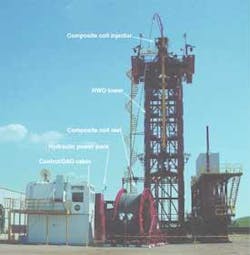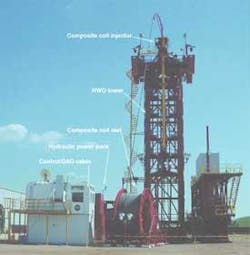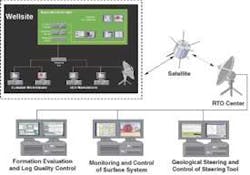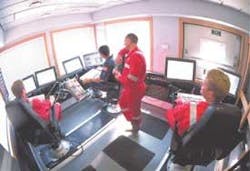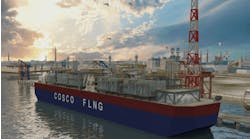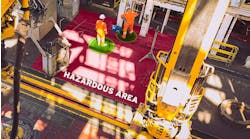Novel composite drilling system aides in production of inaccessible reserves
By E. Alan Coats, Anaconda Halliburton Energy Services
Since the decline of the cable-tool rig, well construction operations have been per-formed exclusively with some variation of steel tubulars. Recently, a drilling sys-tem that combines composite coiled-tubing technology and hydraulic workover technology has been introduced. The Anaconda system is based on breakthrough advances in composite materials, telemetry, and system-control sciences.
Halliburton and Statoil originally developed the first phase of this technology to produce inaccessible reserves in Statoil's mature North Sea fields. The digitally controlled system uses SmartPipe (SP), a carbon-fiber composite umbilical with embedded conductors, and a unique, multi-function bottom hole assembly (BHA). The result is a step forward in well construction and intervention technology. Key design features include reduced weight and space requirements, smaller crew sizes, and a greater capability to drill difficult, complex well paths.
Real-time data transmission
With this system, the industry has the ability to find and develop elusive pockets of oil and gas. Personnel can make drilling decisions from anywhere in the world. Geologists and geophysicists will be able to play a much greater role in drilling operations by remotely directing the path of the well.
Drilling system
The equipment in the new drilling system includes a coiled-tubing unit, hydraulic workover (HWO) unit, supporting tower structure, blowout preventers (BOPs), a fluid system, the digital control and data-acquisition system, SP, and BHA.
Incorporating a HWO jacking system as an integral part of the unit expanded the operating envelope and functionality of the entire system. The addition of the unit also increased the versatility of the system for a broader range of operations. For example, it allows for jointed pipe drilling in both underbalanced and overbalanced situations, and it serves as a platform to perform jointed pipe completions. It also allows for light pipe conditions to be handled as a normal part of the operation from pushing completions into a deviated well to performing underbalanced drilling or completions work.
When combined with the composite coiled tubing drilling unit, the resultant hybrid drilling system greatly expands the options now available for developing hydrocarbon reserves. The new hybrid unit is capable of running either coiled pipe or jointed pipe. The unit can push or pull the drill pipe, logging tools, or completion equipment into and out of the well as required.
Data transmission
Because of the unique properties of the composite pipe, the amount of downhole data transmitted to the surface is several thousand times greater than with conventional systems. With this information, the wellbore can be placed more precisely within a given hydrocarbon zone. Additionally, the capability for transmitting electrical power and commands through the pipe adds increased versatility and control to the drilling process, improving well control and avoiding many hazardous conditions.
Real-time collaboration
The system uses state-of-the-art information technology for system control, telemetry, and real-time communication, which helps enable oil companies to make rapid decisions either on the drilling location or remotely. This makes possible the efficient collaboration of multidisciplinary teams regardless of their proximity to the drilling operation.
In exploration applications, the well construction team can find isolated and bypassed pockets of oil and gas by maneuvering the BHA through the subsurface. Real-time bottomhole data allows personnel to perform intricate geosteering remotely. This new technology uses computerized control systems and can be run with just a series of mouse clicks by the operators.
In the control center, a three-man team operates the entire system. A pilot runs the equipment, a systems engineer maintains the system integrity, and a navigator interprets the sensor data, builds a detailed surface map, and guides the well path accordingly. When required, any of these functions can be performed remotely.
This technology brings together formation evaluation experts, drilling engineers, geologists, and geophysicists so that better decisions can be made while the well path is being drilled. The advanced well paths can be guided with real-time updates of the earth model.
Enabling technologies
The SP is manufactured in a continuous coil using a tough laminate of carbon fiber and other advanced materials. Under most drilling conditions, the pipe is nearly buoyant, which significantly reduces weight and drag compared to steel tubulars. Additionally, the reeled pipe eliminates the need for hazardous pipe-handling operations common with jointed steel drill pipe. The SP is inert to most chemicals and does not corrode. The first system uses 3.125-in. outside diameter (OD) SP with embedded conductors that relay two-way data from the control center at the surface.
The embedded conductors in the pipe enable two-way communication with the BHA. With the wired SP, there is no need for the BHA to contain downhole batteries, turbines, or mud pulsers. Continuously transmitting data to the surface for processing eliminates the need for downhole processing or memory modules. This significantly lessens the complexity of the BHA. Less tool complexity can mean fewer failures.
The BHA has sensors to measure the bottomhole parameters including annulus pressure, delta pressure across the motor, weight on bit (WOB) tension and compression, temperature, survey, directional gamma, and resistivity. Commands from the surface control motors in the BHA that control the bend angle of the 3D tool, backpressure valves, electric disconnect, and actions of the tractor.
Applications
The system has been built for slim-hole sidetracking and well deepening operations. The system's steerability, coupled with its high-resolution downhole information, is suited for the geosteering of complex or designer well paths. With the ability to place the wellbore in a specified formation, a well can be optimally completed to produce the hydrocarbons. Specific slim hole applications are medium to short radius type horizontal wells and extended reach (measured depth to total depth greater than 2:1) shallow gas wells. Deepwater, slim-hole exploration drilling with smaller and early generation rig types is another potential application.
Future developments of this technology include the introduction of well configurations that provide new approaches to well stimulation and logging of extended-reach wells. Also, new completion systems, based on SP, will enable full-time monitoring of reservoir parameters and activation of downhole components.
